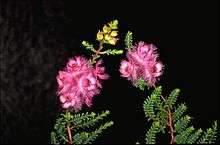Verticordia tumida
| summer featherflower | |
|---|---|
 | |
| Scientific classification | |
| Kingdom: | Plantae |
| (unranked): | Angiosperms |
| (unranked): | Eudicots |
| (unranked): | Rosids |
| Order: | Myrtales |
| Family: | Myrtaceae |
| Genus: | Verticordia |
| Subgenus: | Eperephes |
| Section: | Verticordella |
| Species: | V. tumida |
| Binomial name | |
| Verticordia tumida A.S.George[1] | |
Verticordia tumida, commonly known as summer featherflower, is a flowering plant in the myrtle family, Myrtaceae and is endemic to the north-west of Western Australia. It is an open shrub with very small leaves and clusters of deep pink flowers from late spring to early winter.
Description
Verticordia tumida is an open shrub with many side-branches and which usually grows to a height of 80 cm (30 in). The leaves are elliptic or egg-shaped, 1–3 mm (0.04–0.1 in) long and about 1 mm (0.04 in) wide.[2]
The flowers are scented and arranged in short, spike-like groups near the ends of the branches, each flower on a spreading stalk 2–3 mm (0.08–0.1 in) long. The floral cup is top-shaped, about 3 mm (0.1 in) long and glabrous with thick green appendages 1–2 mm (0.04–0.08 in) long. The sepals are 5–6 mm (0.20–0.24 in) long, spreading, deep pink with 5 or 10 feathery lobes. The petals are a similar colour to the petals, about 5 mm (0.2 in) long, with a fringe 2.5 mm (0.1 in) long. The style is about 4 mm (0.2 in) long, curved near the tip and hairy. Flowering time is from late October to April, sometimes later.[2]
Taxonomy and naming
Verticordia tumida was first formally described by Alex George in 1991 from a specimen collected near Tammin by Charles Gardner. The description was published in Nuytsia.[1][3] The specific epithet (tumida) is a Latin words meaning "swollen"[4] referring to the appendages on the hypanthium.[2]
George placed this species in Subgenus Eperephes, Section Verticordella along with V. halophila, V. pennigera, V. blepharophylla, V. lindleyi, V. carinata, V. attenuata, V. drummondii, V. wonganensis, V. paludosa, V. luteola, V. bifimbriata, V. mitodes, V. centipeda, V. auriculata, V. pholidophylla, V. spicata and V. hughanii.[3]
There are two subspecies:
- Verticordia tumida A.S.George subsp. tumida which has 9 or 10 lobes on each of the sepals and a constriction at the base of the floral cup;[2][5]
- Verticordia tumida subsp. therogana A.S.George which 5 to 8 sepal lobes and no constriction of the floral cup.[2][6]
Distribution and habitat
Subspecies tumida usually grows in sand, sometimes with loam and clay, in heath and shrubland and mainly occurs between Dowerin, Jitarning and Koolyanobbing. Subspecies therogana grows in sand, often with loam in heath and shrubland between Wickepin and the Peak Charles and the Fitzgerald River National Parks.[2]
Conservation
Both subspecies of V. tumida are classified as "Not Threatened" by the Western Australian Government Department of Parks and Wildlife.[7][8]
Use in horticulture
Subspecies therogana has been propagated from cuttings more easily than has subsp. tumida. It is also easier to maintain in the garden but not to the degree that it is available in commercial horticulture.[2]
References
- 1 2 "Verticordia tumida". APNI. Retrieved 22 July 2016.
- 1 2 3 4 5 6 7 Elizabeth A. (Berndt) George; Margaret Pieroni (illustrator) (2002). Verticordia: the turner of hearts (1st ed.). Crawley, Western Australia: University of Western Australia Press. pp. 342–344. ISBN 1-876268-46-8.
- 1 2 George, Alex (1991). "New taxa, combinations and typifications in Verticordia (Myrtaceae : Chamelaucieae)". Nuytsia. 7 (3): 231–394.
- ↑ Brown, Roland Wilbur (1956). The Composition of Scientific Words. Washington, D.C.: Smithsonian Institution Press. p. 774.
- ↑ "Verticordia tumida subsp. tumida". APNI. Retrieved 29 July 2016.
- ↑ "Verticordia tumida subsp. therogana". APNI. Retrieved 29 July 2016.
- ↑ "Verticordia tumida tumida". FloraBase. Western Australian Government Department of Parks and Wildlife.
- ↑ "Verticordia tumida therogana". FloraBase. Western Australian Government Department of Parks and Wildlife.
